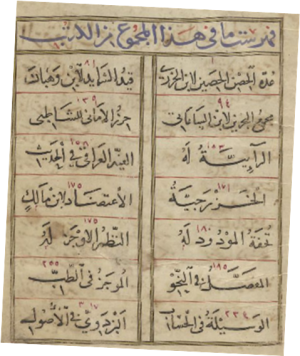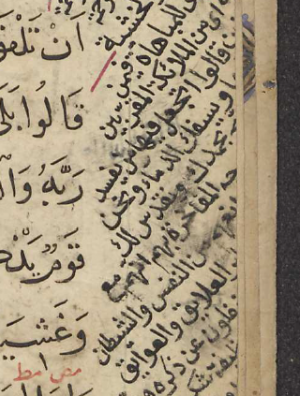About this manuscript
ʿUddat al-ḥiṣn al-ḥaṣīn is a prayerbook, a collection by the Mamluk-era scholar Ibn al-Jazarī, of some 600 different supplications to God (duꜤā’) in the words of the Prophet himself (see lesson 20). It contains invocations for specific times of the day and times of the year, for weddings, eating and fasting and numerous other occasions. Al-Jazarī also published an even larger collection, but it is this abridgement that rapidly became popular throughout the Muslim world, from the Maghrib to Malaysia. Printed editions continue to be published today.


Manuscript versions of ʿUddat al-ḥiṣn al-ḥaṣīn were often bound together with other devotional works. In a codex of the Staatsbibliothek in Berlin for instance, it is the final text in a majmūꜤa containing highly-popular devotional texts all associated with the Shadhiliyya Sufi brotherhood. The Leiden copy of ʿUddat al-ḥiṣn al-ḥaṣīn was originally the opening work of a collection of fourteen quite different texts, as we can see in its index on f3recto.
According to that fihrist, its last text, al-Bazdawī fī’l-uṣūl,
began on f 317. Our manuscript, however, ends on the folium marked
81 in pencil. It has been separated to form a stand-alone codex, perhaps
indeed as a present or to carry on a journey. A book of prayer was the
ideal companion for travellers in any religion and they were often
produced in small sizes for that purpose.
Now examine the book covers of this manuscript. You will find that
their ornaments - the blind-tooled medallions - are not the same.
Apparently two second-hand book covers were recycled for the new codex.
Perhaps the front cover belonged to the original convolute. The two
fly-leaves with notes and lines of poetry of previous owners also seem
to have been transferred from the original convolute: they were damaged
by fraying at the edges, and they were repaired with strips of paper
that was also recycled (note the page-number in the upper right corner).

Before binding the new book-block, the folia were also trimmed and repaired. The date of the trimming and repairs are not recorded on the manuscript, but they were certainly made subsequent to the writing of the comments in the book's margins, since a number of those marginal notes (for instance on f7 recto and verso) are truncated.
More about this manuscript: lessons 20 and 22.
Questions
-
According to the index the second work in the convolute began on folium 81. However, ʿUddat al-ḥiṣn al-ḥaṣīn ends on a folium marked 81 in pencil. What explains the discrepancy? Look at the page numbers in the manuscript and note that in some places Arabic page numbers have survived the trimming of the folia. Where? Were they the numbers of the original convolute or were they added later?
-
Why was the index of the complete majmūꜤa included in this book of prayer, even though the book was detached from the rest of the collection?
Assignments
-
Which of the titles in the index on folio f3recto can you find in Brockelmann’s Geschichte der Arabischen Literatur? Who were the authors and what are the topics? What kind of collection was the volume from which these pages were taken?
-
Once a manuscript is trimmed as Leiden Or. 14.076, it is difficult to know how much paper was cut away. In some cases, however, we can make an estimation. In the case of Or. 14.076, a reader of the manuscript left marginal notes which were truncated when the pages were trimmed. The annotations which the note-maker added in the margins are other hadiths about supplication to God along with explanations. Many of these same expressions are contained in the chapter on supplications by the Indian hadith scholar ʿUbayd Allāh al-Mubārakfūrī' Mirʿāt al-mafātīḥ, and by comparing the full text in al-Mubārakfūrī's book with the annotations in manuscript Or. 14.076, we can reconstruct how much text is missing, and roughly estimate the minimum extent of the trimming.
Find the statements from the excerpt from Mirʿāt al-mafātīḥ (vol.7 p.384) in the marginal note on f.7r in the manuscript, and determine what words are missing in the left-hand margin. Based on the missing words, what do you estimate the minimum amount of trimming was?
